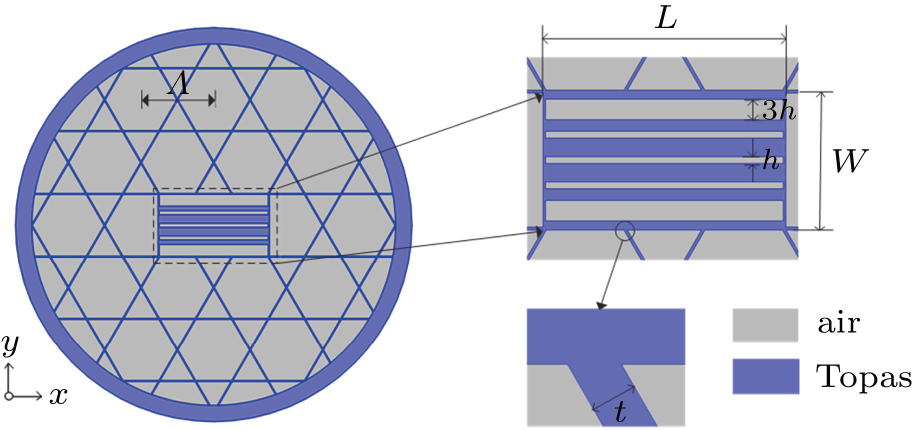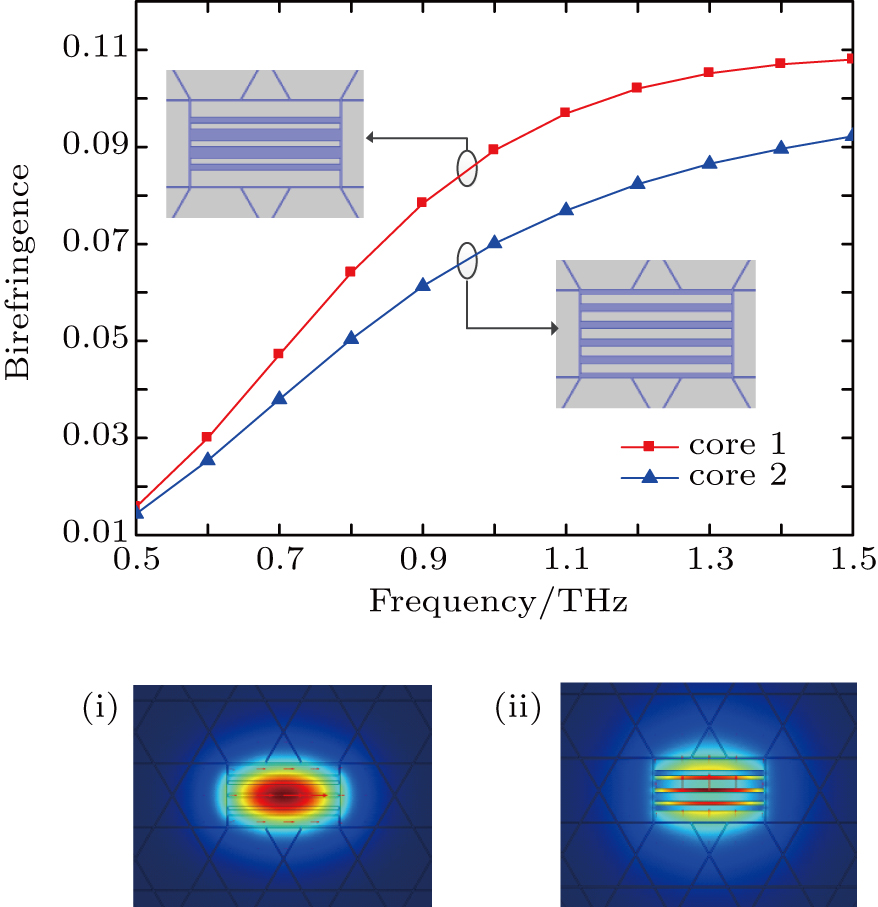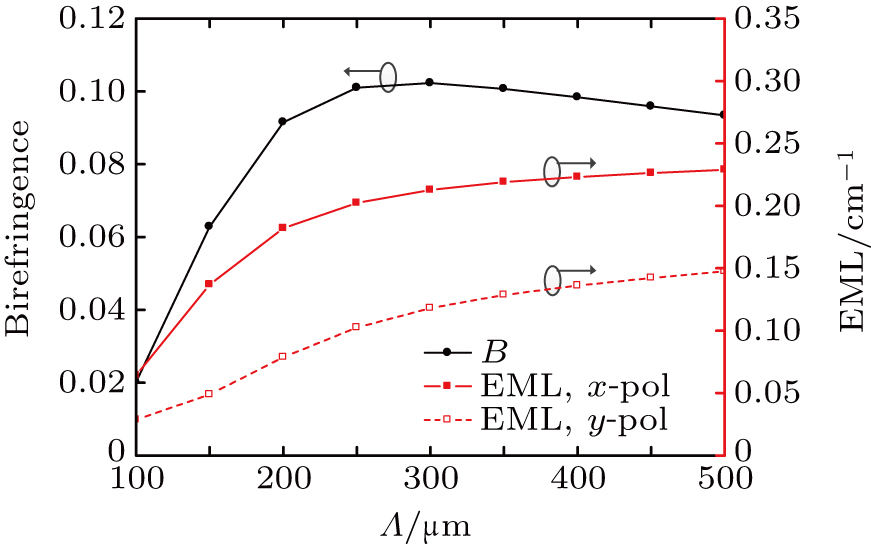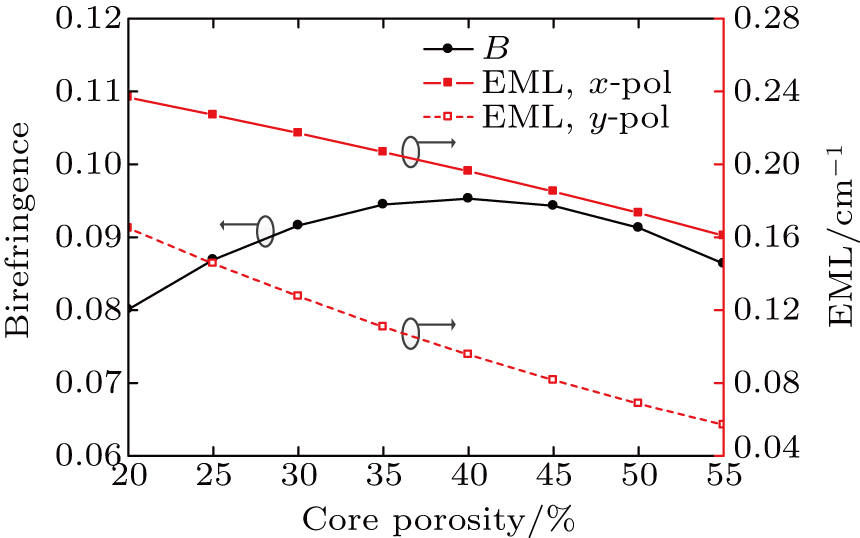Project supported by the National Natural Science Foundation of China (Grant No. 11604260) and the Outstanding Youth Science Fund of Xi’an University of Science and Technology, China (Grant No. 2019YQ3-10).
Project supported by the National Natural Science Foundation of China (Grant No. 11604260) and the Outstanding Youth Science Fund of Xi’an University of Science and Technology, China (Grant No. 2019YQ3-10).
† Corresponding author. E-mail:
Project supported by the National Natural Science Foundation of China (Grant No. 11604260) and the Outstanding Youth Science Fund of Xi’an University of Science and Technology, China (Grant No. 2019YQ3-10).
A type of photonic crystal fiber based on Kagome lattice cladding and slot air holes in a rectangular core is investigated. Full vector finite element method is used to evaluate the modal and propagation properties of the designed fiber. High birefringence of 0.089 and low effective material loss of 0.055 cm−1 are obtained at 1 THz. The y-polarized fundamental mode of the designed fiber shows a flattened and near-zero dispersion of 0 ± 0.45 ps · THz−1 · cm−1 within a broad frequency range (0.5 THz–1.5 THz). Our results provide the theory basis for applications of the designed fiber in terahertz polarization maintaining systems.
The electromagnetic wave located between the microwaves and infrared region is commonly defined as terahertz (THz) radiation with frequency domain from 0.1 THz to 10 THz. Recently, terahertz radiation has attracted significant attention due to its potential applications in sensing,[1] imaging,[2] time-domain spectroscopy,[3] pharmaceutical drug testing,[4] and communication,[5] etc. However, THz systems that rely on free-space and bulk optics to transport and manipulate the THz radiation are large and immobile, difficult to use and integrate with infrared and optical systems. In order to solve this problem, various THz waveguides have been reported, including metallic waveguides,[6] dielectric tubes,[7] Bragg fibers,[8] plastic ribbons,[9] photonic crystal fibers (PCFs),[10–17] etc. Porous core PCFs have aroused the interest of the researchers widely for their low absorption loss, low dispersion, and high degree of design freedom. Besides, high birefringence can be achieved by breaking the symmetry of the core or cladding region of the porous core PCFs.
THz fiber with high birefringence has potential applications in THz systems, so a variety of highly birefringent THz PCFs have been investigated in recent years. Cho et al.[11] fabricated a plastic PCF that exhibits a birefringence of 0.021 at 0.3 THz. Atakaramians et al.[12] designed a porous fiber with slot air holes and obtained a birefringence of about 0.026 at 0.6 THz. Chen et al.[13] proposed a porous fiber with elliptical air-holes and obtained a high birefringence of 0.047 at 1.22 THz with the elliptical air-holes rotating at 30°. Hasan et al.[14] designed a spiral PCF with artificial asymmetry in the porous core and obtained a birefringence of 0.0483 at 1 THz.
Low loss and other characteristics, such as flattened and near-zero dispersion are necessary for practical applications of THz fibers, in addition to high birefringence. Wu et al.[15] proposed an oligoporous-core THz PCF with a birefringence of 0.03 and a low effective material loss of about 20%–40% of its bulk material loss. Habib et al.[16] presented a THz fiber with a rectangular core to realize a birefringence of 0.018 at 1 THz and a low flattened dispersion of 1.1 ± 0.02 ps · THz−1 · cm−1 in a frequency range of 0.8 THz–1.2 THz. Islam et al.[17] designed an oligoporous-core PCF with Kagome lattice cladding, which has a high birefringence of 0.079, low effective material loss of 0.05 cm−1 at 1 THz. Although the performances (i.e., the low loss, high birefringence, low/flattened dispersion) of THz PCFs have been improved individually or wholly, there is still much room for further improvement by designing fiber structures.
In this paper, a THz PCF with Kagome-structured cladding and rectangular core with slot air holes is designed. The designed PCF presents high birefringence, low loss and flattened near zero dispersion properties in a broad frequency range. The designed fiber structure has not been reported to the best of our knowledge, and it has potential applications in polarization-maintaining THz systems.
Cross section of the designed THz PCF is shown in Fig. 
Material Topas is used as a background material in our design on account of its low material dispersion (with a constant refractive index of 1.5258) and relatively low material loss (rises at a rate of 0.36 cm−1/THz from 0.06 cm−1 at 0.4 THz) in a range of 0.1 THz–1.5 THz,[18] low water absorption (∼ 1/10 of the PMMA), and chemical resistance to common solvents.[19]
The modal and propagation properties of the designed THz PCF are studied theoretically with the finite element method (FEM). Perfectly matched layer (PML) absorbing boundary condition is used to calculate the confinement loss.
As an important parameter for a polarization maintaining THz waveguide, the birefringence is defined as the absolute difference between the effective indexes of x- and y-polarized fundamental modes:[13]
 |


The major transmission loss of PCF can be attributed to material absorption loss and confinement loss (CL). It is hard to fabricate a low loss THz fiber experimentally due to the fact that all materials except dry air have relatively high absorption coefficient for THz radiation. The material absorption loss of THz fiber can be reduced by maximizing the power fraction of the fundamental modes in air. The effective material loss (EML) of the fundamental modes, caused by material absorption, can be expressed as[20]
 |
The CL depends mainly on the number of cladding hole rings and core porosity, it represents the ability to restrict the light in the core. The CL can be calculated from the following expression[21]
 |
Dispersion is also an important propagation property for THz waveguide as it degrades the signal in broadband or long distance transmission. Flattened and near-zero dispersion is necessary for the effective transmission of broadband THz waves. Firstly, it is necessary to ensure single mode propagation in order to reduce intermodal dispersion. The single mode condition for index guiding PCF can be determined by the normalized frequency expressed by the V-parameter[13]
 |
 |
Different core structures have been studied in order to obtain high birefringence. We find that the core structure with different slot air hole widths (defined as core 1) can introduce higher birefringence than the one with equal slot air hole width (defined as core 2) although their porosities are equal as shown in Fig.
Figures
Scalability dependence of the birefringence and EML have been studied in order to obtain the optimal structure parameters. Figure
For realistic PCFs, the guided modes are inherently leaky as a result of the finite number of cladding hole rings, and confinement loss occurs inevitably. However, transmission loss of THz PCF is mainly derived from material absorption loss rather than confinement loss, especially for the PCF with Kagome lattice cladding. In order to make it flexible and compact, the THz fiber should be as thin as possible, i.e., the cladding hole rings should be as few as possible. Figure
 | Fig. 4. Birefringence and loss (EML and CL) versus cladding hole ring number at 1 THz, with inset showing magnified variation trend of CL (Λ = 200 μm, t = 0.015Λ, core porosity = 55%). |
For an index guiding porous-core PCF, the material absorption loss can be reduced by maximizing the power fraction of the fundamental modes in air, which is closely related to the core porosity. Figure
For Kagome-structured PCFs that may be fabricated by the stack-and-drawing, extrusion and even the flexible and accurate 3D printing technique, the relative strut-thickness (t/Λ) is also an important parameter that can affect propagation properties of the fiber.[22–25] Figure
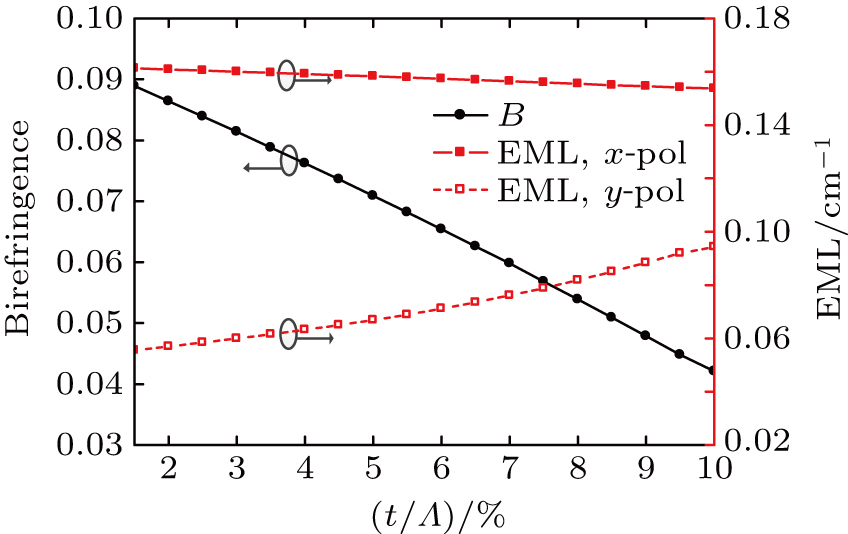 | Fig. 6. Plot of birefringence and EML versus relative strut thickness at 1 THz (Λ = 200 μm, core porosity = 55%). |
By comparing Figs.
(i) The structural parameter dependence of birefringence and loss are different and even conflicting with each other as a result of their different origins.
(ii) Birefringences are of the same order of magnitude (10−2) although their variations with structural parameters (lattice pitch, cladding hole ring number, core porosity and relative strut thickness) are different. However, the variations of EML with structural parameters are relatively dramatic (from 0.04 cm−1 to 0.25 cm−1). So the structural parameters with lower loss are adopted rather than the ones with higher birefringence when they are conflicting with each other (as shown in Fig.
(iii) Considering a tradeoff between high birefringence and low EML, the structural parameters with Λ = 200 μm, rings = 2, core porosity = 55% and t/Λ = 1.5% are adopted for the optimal THz PCF.
The V-parameter and dispersion characteristics of the designed optimum THz PCF are shown in Figs.
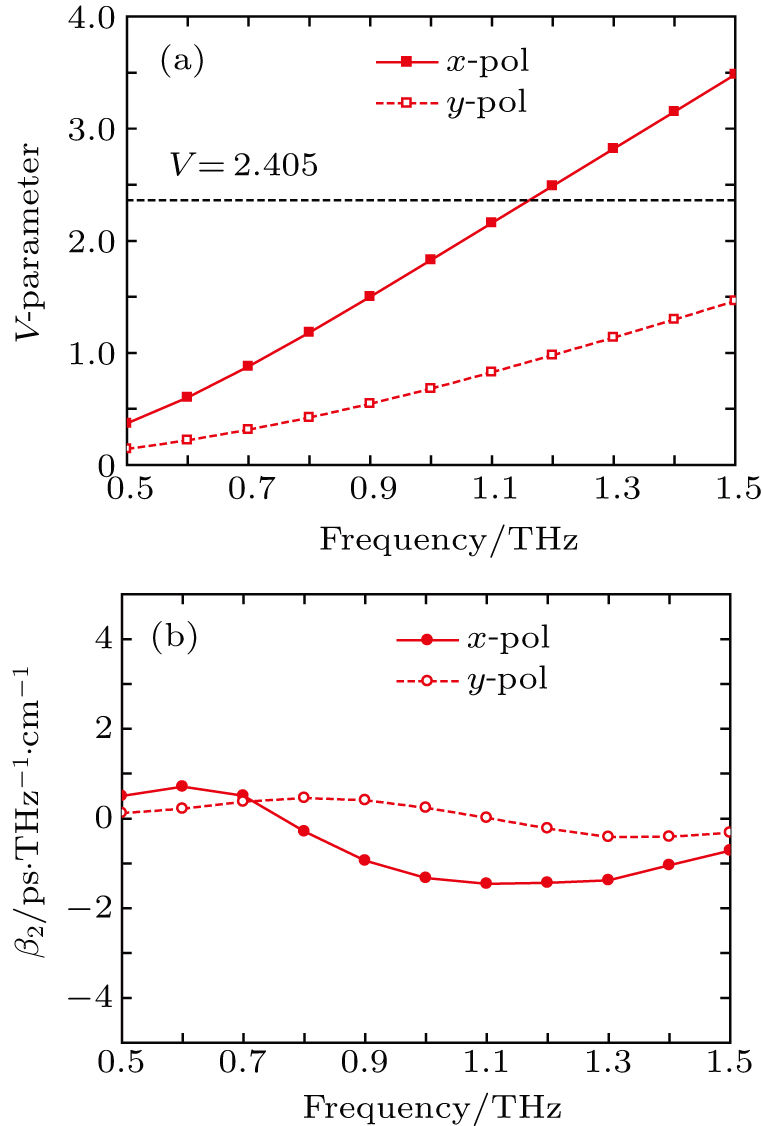 | Fig. 7. (a) V-parameter and (b) dispersion versus frequency of the fundamental modes for the optimized THz PCF. |
The propagation properties of the designed THz PCF are compared with the recently reported PCF’s as listed in Table
| Table 1. Comparison of propagation properties between designed THz PCF and other PCF’s. . |
It is necessary to discuss the fabrication possibilities of our proposed THz PCF for its practical implementation. There are many ways to fabricate the polymer-based PCFs compared with silica-based ones. Beside the stacking-and-drawing of capillaries, which is suitable for making PCFs with circular air holes arranged in triangular lattice, the extrusion, casting, molding, and drilling have been used successfully to made polymer PCFs with various complex and asymmetrical structures.[28] Moreover, the most recently developed 3D printing technique has been used to produced THz waveguides with complicated and small features, and the most advanced laser-based 3D printing techniques can realize a printing resolution of the order of micrometer in x and y dimensions.[29,30] Kagome lattice PCF and porous core PCF with non-circular slot air holes are fabricated successfully by using the stack-and-draw, 3D printing, extrusion techniques, etc.[23,31,32]
The structure of our proposed THz PCF with Kagome lattice cladding and slot air holes is relatively simple and robust compared with the PCFs operating in the telecommunication range, and the fabrication possibility is considered during the structural parameter optimization. So, it is possible to fabricate the designed THz PCF by using or combining the existing techniques, such as drawing from a 3D-printed preform.[33] In our previous papers, experimental investigations have been carried out for the fabrication of polymer-based PCFs.[34,35] The designed THz PCF in this paper will be fabricated in our consequent researches.
An improved Kagome PCF with slot air holes in a rectangular core is designed for the transmission of THz waves. Structural parameter dependence of the propagation properties such as birefringence, material absorption loss (effective modal loss), confinement loss and dispersion are numerically investigated by using the full-vector FEM. The simulation results indicate that even two rings of cladding holes can obtain a negligible confinement loss. Ultra high birefringence of 0.089 and low effective material absorption loss of 0.055 cm−1 are obtained at 1 THz for the optimized fiber structure. Besides, the y-polarized fundamental mode shows an ultra-flattened and near-zero dispersion of 0 ± 0.45 ps · THz−1 · cm−1 over 0.5 THz–1.5 THz. The designed THz PCF shows improved propagation properties compared with the recent reported PCF’s and its structure is relatively simple and manufacturable. Thus, the designed Kagome PCF has potential applications in fields of THz communication and polarization maintaining systems.
| [1] | |
| [2] | |
| [3] | |
| [4] | |
| [5] | |
| [6] | |
| [7] | |
| [8] | |
| [9] | |
| [10] | |
| [11] | |
| [12] | |
| [13] | |
| [14] | |
| [15] | |
| [16] | |
| [17] | |
| [18] | |
| [19] | |
| [20] | |
| [21] | |
| [22] | |
| [23] | |
| [24] | |
| [25] | |
| [26] | |
| [27] | |
| [28] | |
| [29] | |
| [30] | |
| [31] | |
| [32] | |
| [33] | |
| [34] | |
| [35] |



